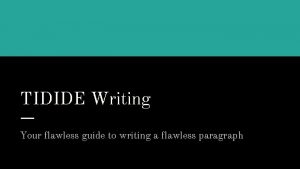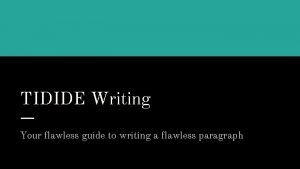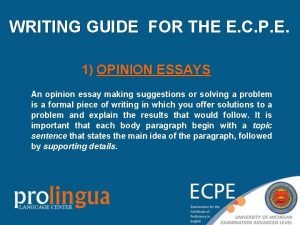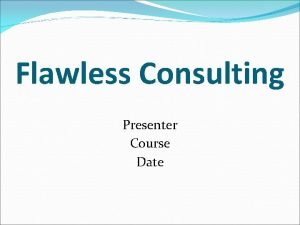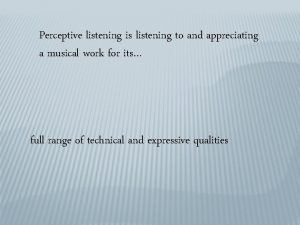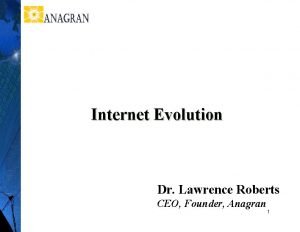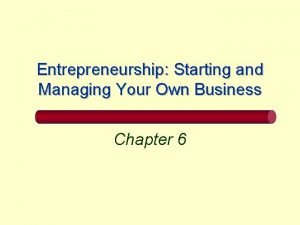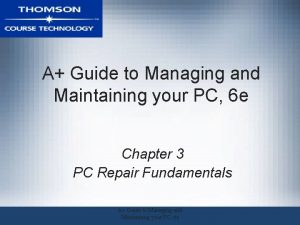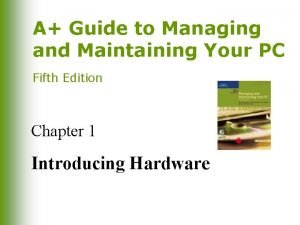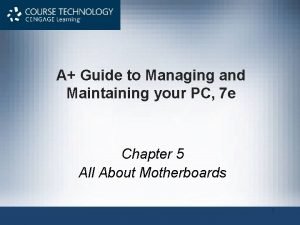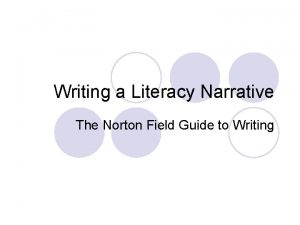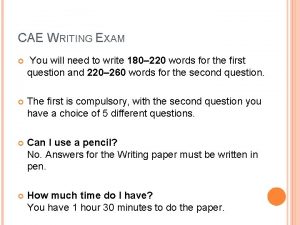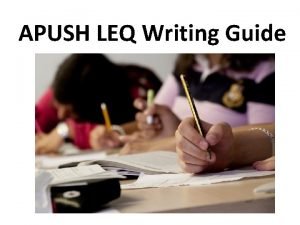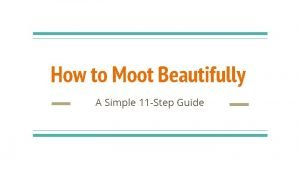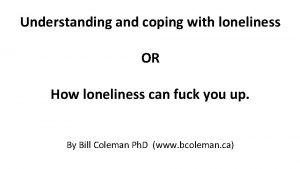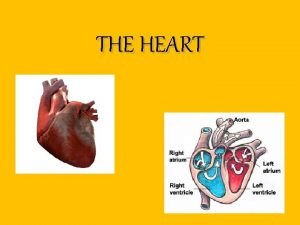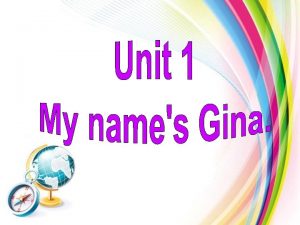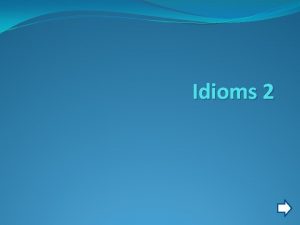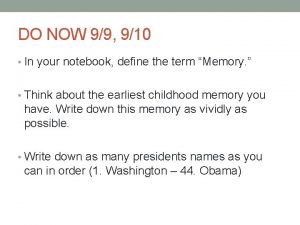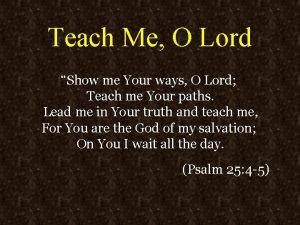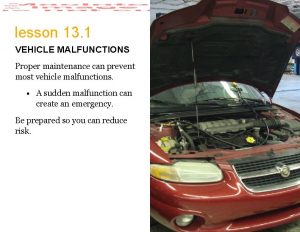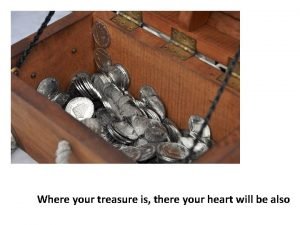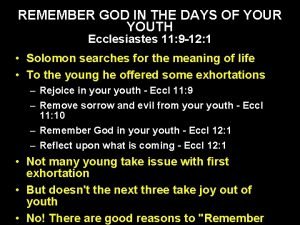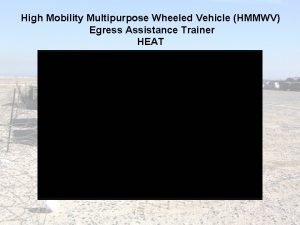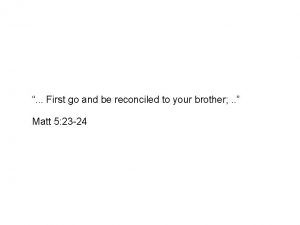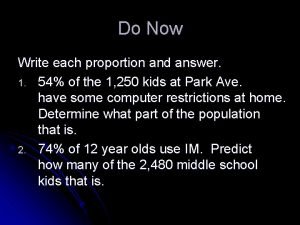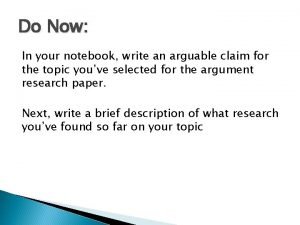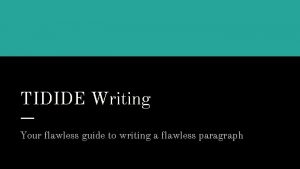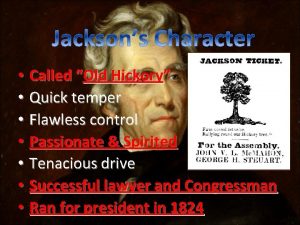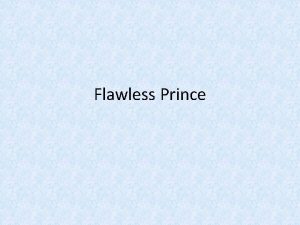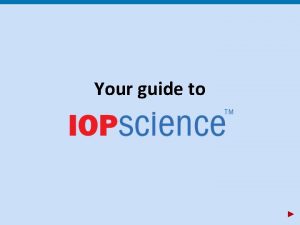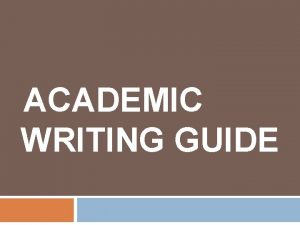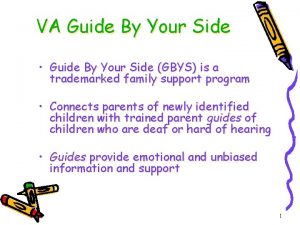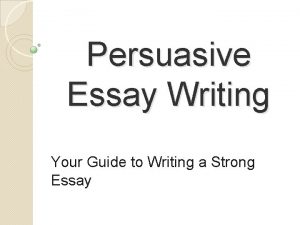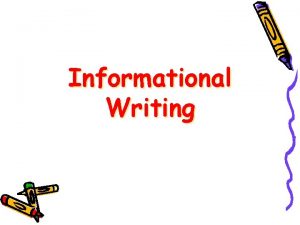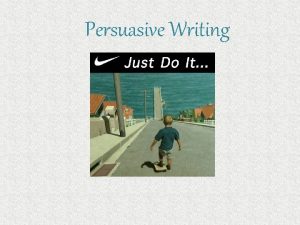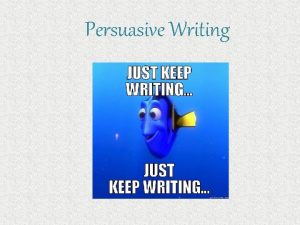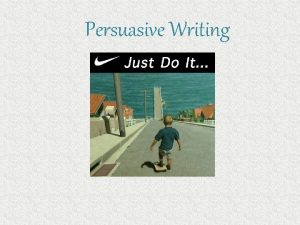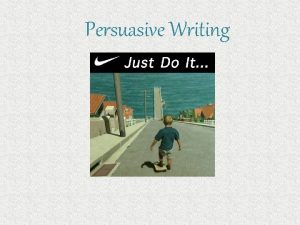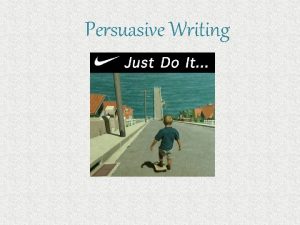TIDIDE Writing Your flawless guide to writing a





































- Slides: 37

TIDIDE Writing Your flawless guide to writing a flawless paragraph

T- TOPIC SENTENCE If a thesis is a road map to a paper, then a topic sentence is a guide to a paragraph. Therefore, you should think of topic sentences as kinds of mini-theses, organizing and enabling the development of each paragraph in a paper. Use specific language in your topic sentences and avoid making broad, sweeping generalizations (Write: BE SPECIFIC) Vague Topic Sentence: Public schools are great. Stronger Topic Sentence: Public schools do as well academically as private schools, according to statistics.

T- TOPIC SENTENCE The purposes of a topic sentence: 1. To support an essay’s thesis statement 2. To unify a paragraph with a general sense of organization 3. To present to the audience the subject to be discussed Topic sentences do not have evidence (a quote). These are all your words. Topic sentences include an INFERENCE (remember: an educational guess).

T- TOPIC SENTENCE Cool. But what is an inference? An inference is something that you think is true based on information that you have. An inference is NOT directly written in the text. To make an inference, we use evidence from the text, and our prior knowledge. Sometimes we have to “read between the lines. ” Authors don’t always tell us everything. We need to use textual evidence and prior knowledge to understand the text better.

T- TOPIC SENTENCE Thesis: “Dogs make the best pets because they are loyal, friendly and smart. ” Body Paragraph 1 Topic Sentence: Loyalty “A dog shows loyalty to its owner by following commands. ”. . . Bad Example: Thomas Jefferson was born in 1743. Better Example: Thomas Jefferson, born in 1743, made important contributions to American culture.

T- TOPIC SENTENCE Bad: I love my sister. Better: I love my sister for her creativity and her kindness. Bad: George Lucas is a filmmaker. Better: George Lucas is an influential filmmaker who has changed cinema in a few important ways. Bad: My father has always loved me. Better: My father is a strong and confident man who has helped me become the person that I am today.

I- Important Evidence When we have ideas about what we read, we need to cite textual evidence to support our ideas. (WORD-FOR-WORD QUOTES) When we read, we often are asked to answer questions or express our ideas about the text. In order to let people know we aren’t making stuff up, we use textual evidence to support our opinions or answers. Remember, in literature, your answer is always right, if you can defend the answer with textual evidence. Explicit (direct) Textual (from the text) Evidence (support for your answer, opinion, or idea).

I- Important Evidence To add evidence, you just have to do three things: 1. State your idea: State the idea you had about the text (if you are responding to a specific question, be sure your idea restates the question). THIS IS YOUR TOPIC SENTENCE 2. Cite what in the text led you to that idea: Give supporting evidence from the text. You must use quotation marks. Sentence starters = In the first paragraph, _____ the author says. . . The text states. . . The text describes/For example. . . The author explains. . . Early in the text, the author/For instance… Six or less words. THIS IS YOUR “I” SENTENCE

I- Important Evidence 3. Explain the Evidence: Explain how the quote(s) or paraphrase(s) you pointed out support your idea. Sentence starters = This shows. . . This is because. . . This means. . . This reveals. . . This illustrates. . . This highlights the difference between. . . THIS IS YOUR “D” SENTENCE. (I’ll explain this later) In order to avoid plagiarism, you need to CITE your evidence. You do this by: 1. Putting quotes around the word-for-word quotation 2. Cite where you found iti. “BLAH” (Smolko 7).

I- Important Evidence When you are “embedding” textual evidence, it means that you are incorporating a quote, statistic, or fact directly into the text of a paragraph. Textual evidence is not randomly added to the text of a paragraph. The paragraph is actually constructed around the supporting evidence and serves to describe the evidence and how it connects to the student’s thesis statement. Wrong: A dog shows loyalty to its owner by following commands. “Cats kill between 1. 4 billion and 3. 7 billion birds every year in the United States alone, a new report concludes. ” Dogs are quick to learn the tricks given by their owners.

I- Important Evidence Better, but weird: A dog shows loyalty to its owner by following commands, while cats are not. In the article, “Cats Hate Birds” by Tom Tigerson, Tigerson argues that cats, on the other hand, refuse their owners’ commands by doing reckless acts that go against the humans’ wishes, such as murder; in fact, “Cats kill between 1. 4 billion and 3. 7 billion birds” every year. This statistic proves that cats are unloyal. However, dogs are quick to learn the tricks given by their owners… This is a stretch, but do you see where I’m coming from?

I- Important Evidence How do you go about “embedding” supporting evidence into a paragraph? 1. Use a brief phrase to introduce the supporting evidence. The “brief phrase” is a sentence that describes the supporting evidence. It may include where the evidence came from, and/or who created it. 2. Insert the quote, statistic, or fact that you are using as supporting evidence. Students should incorporate their supporting evidence in such a way that their paragraphs do not sound awkward or forced. 3. Explain how the supporting evidence connects to your thesis statement. After the textual evidence, students should write one or two sentences that demonstrate how the textual evidence justifies their position on the topic. “D”

I- Important Evidence Embedding Example: From the First Page of Catcher in the Rye by J. D. Salinger: "If you really want to hear about it, the first thing you'll probably want to know is where I was born, and what my lousy childhood was like, and how my parents were occupied and all before they had me, and all that David Copperfield kind of crap, but I don't feel like going into it, if you want to know the truth. "

I- Important Evidence How does Holden feel about his childhood? Holden feels that his childhood was miserable. In fact, before he reveals any other information about himself, he guesses that the reader will be interested in his "lousy childhood" (Salinger 1). The first page emphasizes that Holden views his early years negatively; therefore, he avoids discussing that time in his life.

D- Detailed Explanation You made your claim/inference in the topic sentence and you found evidence from the text to support it. NOW, you must write about the connection between the your inference and the quote. Why did you pick that quote? How does that evidence relate to your topic sentence? Why? How? What do you mean/ see? Go further! Here comes your analysis.

D- Detailed Explanation This critical stage is often the most difficult for many students. There are two types of writing: Descriptive writing and analytical writing. Descriptive writing answers the "who, " "what, " "where, " and "how" questions. It often tends to summarize the text. Analytical writing, however, answers to the "why" question. When you consider the question, "Why is this point important? ", it pushes you beyond mere description/ summary into ideas that are convincing, argumentative, and defend a position. Remember, write as if the audience has already read the text you are talking about. Never summarize, you are past this point.

D- Detailed Explanation What do I even analyze? For literary analysis, common areas to explore in a text include: ● Identifying common themes, repetitions, and patterns. ● Categorizing elements, tone (the emotion you get from a text), and narrative style (point of view, stream-of-consciousness) ● Highlighting characterization (indirect), setting, and foreshadowing. ● Labeling character types (archetypes), symbols, and metaphors. So the purpose of a “D” sentence is to interpret meaning, dive deeper in a text, reveal something (symbols & such), or show something that is not obvious to the readers.

D- Detailed Explanation “D” Sentences can begin with: ● Suggests that… ● Implies that… ● One can infer that… ● Can be interpreted as… ● Symbolizes the (idea, situation, other theme or object) ● Represents…

Transition After our “T, ” “I, ” and “D” sentence, we need a transitional word or phrase. Why? This establishes flow in between your pieces of textual evidence so things don’t sound choppy or random. Examples: In addition, Also, In the same fashion/ manner/ way, Second, Equally Important, Again, Equally, Moreover, However, Likewise, Additionally, Furthermore,

Imaginary Cat Article- Meow Cats kill between 1. 4 billion and 3. 7 billion birds every year in the United States alone, a new report concludes. That’s nearly a billion more birds — at least — than estimated by some previous studies, Peter Marra told Science News. This research scientist, who works at the Smithsonian Conservation Biology Institute in Washington, D. C. , led the new study. Any long-term solution will be controversial. Some people propose catching wild cats and neutering them, which means performing minor surgery to make them unable to reproduce. That won’t make them kill fewer animals. But it will slow the increase in number of these natural-born killers. Others people have proposed catching and killing feral cats.

TIDID Example The author’s purpose is to make people aware that cats killing birds have become a problem and that any solution to the problem will be controversial. In the first paragraph, the author points out that, “Cats kill between 1. 4 billion and 3. 7 billion every year” (Author’s Last Name pg#). The author’s use of that statistic catches a reader’s eye because of the shocking numbers, which illustrates the gravity of the issue. Then, in the second paragraph, the author says that there are two controversial ways to solve the problem, by either “catching wild cats and performing surgery on them so they cannot reproduce or catching and killing them” (Last Name pg#). The author is demonstrating that the possible solutions are controversial because most people probably would not like the idea of cats being caught in order to either operate on them or kill them.

E- Ending Sentence E Sentences are baby conclusion paragraphs. Students should seize the conclusion as ananalyzing opportunity to provide their own opinion and reflection about their process of the text. This answers the question, “So what? ” In one sentence, summarize the evidence and its role in supporting your inference. Example: Through the evidence, Odysseus’ tone suggests his growing impatience with his disobeying men by displaying a feeling of betrayal.

Thesis Statements Now that you know how to write a topic sentence, thesis statements should come easier to you. Thesis statements are found in the last sentence of the introduction paragraph. A thesis statement is a declarative statement, never a question. Gross: How could we still tolerate sexism in the military today? Better: Even though Americans claim to be enlightened about sexism, sexist language and behaviors still prevail in the military.

Thesis Statements Thesis statements are not commands. Gross: Note the differences between cooks and chefs. Better: Although meals prepared by either cooks or chefs can be equally delicious, chefs differ from cooks in education, professional commitment, and artistry.

Thesis Statements You must be able to argue a thesis statement. They are not facts. Gross: Cortez conquered Mexico in 1509 Better: The colonial mentality which prompted Cortez's barbaric invasion of Mexico brought about not an advance of native society but a destruction of Aztec culture.

Thesis Statements Thesis statements are NOT announcements of the author's purpose or assignment. Please. Gross: In this essay, I will discuss the causes and effects of the French Revolution and then argue as to whether or not it was successful. Ewwwwww. Horrible. I’m so nauseous. Better: Though the reasons for the French Revolution were noble, the effects were devastating, ultimately leading to the unsuccessful reinstitution of the monarchy and the restructuring of a classist society into a militaristic one.

Thesis Statements Just to make sure you get the point: Gross: This essay will explain my reasons for supporting capital punishment for first -degree murderers. #basic #nope Better: First-degree murderers should receive capital punishment because there are too many repeat offenders, because rehabilitation programs have proved ineffective, and because murder is too heinous a crime to be punished by anything less than death.

Thesis Statements Thesis statements are not merely observations of the obvious. Gross: Litter creates pollution of the environment. Better: Recycling programs, though expensive at first, are ultimately an efficient, cost effective, and environmentally sound means of reducing waste in our environment.

Thesis Statements Thesis statements are not unarguable personal opinions. Gross: I like chocolate. Better: Even though chocolate tantalizes my taste buds and satiates my emotional need to be loved, it causes weight gain, clogs arteries, and contains caffeine.

Thesis Statements Thesis statements cover only one topic. Gross: The theme, characters, setting, irony, conflicts, viewpoint, and plot all contribute to making Madame Bovary a tragedy. Better: Flaubert's Emma Bovary is a tragic character because, never seeing reality, she misses some important clues that her life has gone awry, and she falls from her social "height" into prostitution.

Thesis Statements Thesis statements often focus the essay and guide its direction. Gross: Martin Luther King, Jr. is a role model for everyone to follow. Better: Because of his determination, his courage to follow his beliefs, and his unwavering sense of justice, Martin Luther King, Jr. is a symbol of American freedom.

Thesis Statements Thesis statements are not simplistic. Gross: Cats and dogs look different and act differently. Better: Though seemingly adorable and tame, mountain lion cubs are actually wild, dangerous predators.

Thesis Statements How do I write a thesis statement: A. Decide on your topic. Poetry in the English textbook. B. Narrow your topic. Contrast gender characteristics in two poems: Emily Dickinson's "Because I could not stop for Death" contrasted with John Donne's "Death Be Not Proud“ C. Put your topic in a sentence. Emily Dickinson's "Because I could not stop for Death" is different from John Donne's "Death Be Not Proud. “ D. Add your argument, viewpoint, or opinion to your topic to make your thesis persuasive. Emily Dickinson's "Because I could not stop for Death" is essentially a more feminine poem, while John Donne's "Death Be Not Proud" is more masculine.

Thesis Statements E. Elaborate on your thesis so that it addresses all parts of your assignment. � Although Emily Dickinson and John Donne both personify death in their poems, the tone, language, and images are clearly feminine in "Because I could not stop for Death, " and masculine in "Death Be Not Proud. “ F. Organize your thesis to guide the direction of your paper. Although Emily Dickinson and John Donne both personify death in their poems, the images, language, and tone clearly reveal a woman's perspective in "Because I Could Not Stop for Death, " and a man's perspective in "Holy Sonnet 10. " Boom. You sound so smart.

Conclusion This is your opportunity to wrap up your essay in a tidy package and bring it home for your reader. It is a good idea to recapitulate what you said in your Thesis Statement in order to suggest to your reader that you have accomplished what you set out to accomplish. No new ideas go into the conclusion, only summary and “call to action. ” A “call to action” is the “so what? ” to your paper. Why does this matter? What was the point to this essay? Any themes revealed here?

Conclusion A conclusion is what you will leave with your reader It "wraps up" your essay It demonstrates to the reader that you accomplished what you set out to do It shows how you have proved your thesis It provides the reader with a sense of closure on the topic It is the opposite of your introduction

Conclusion If you can’t imagine dropping the mic after the final sentence in your essay, your conclusion needs to be stronger.
 Tidides
Tidides Tidides
Tidides Opinion essay ecpe
Opinion essay ecpe Flawless consulting workshop
Flawless consulting workshop Flawless consulting workshop
Flawless consulting workshop A sequence of tones arranged in rising pitches
A sequence of tones arranged in rising pitches Fairness and flawless ceo
Fairness and flawless ceo Managing your own business
Managing your own business Give us your hungry your tired your poor
Give us your hungry your tired your poor Guide to managing and maintaining your pc
Guide to managing and maintaining your pc Guide to managing and maintaining your pc
Guide to managing and maintaining your pc Guide to managing and maintaining your pc
Guide to managing and maintaining your pc Formal informal invitation
Formal informal invitation Norton field guide to writing literacy narrative
Norton field guide to writing literacy narrative Letter structure cae
Letter structure cae Leq format
Leq format Mooting skeleton argument example
Mooting skeleton argument example Coping with gay loneliness
Coping with gay loneliness Stop blaming your parents for your problems
Stop blaming your parents for your problems Which side is your heart on
Which side is your heart on A poem is a little path
A poem is a little path Introduce your friend to your teacher
Introduce your friend to your teacher Cara ikatan buku sila
Cara ikatan buku sila In your notebook write questions and answers
In your notebook write questions and answers In your notebook describe the following
In your notebook describe the following Enagic compensation plan
Enagic compensation plan Your conscious awareness of your own name and self identity
Your conscious awareness of your own name and self identity Show me your way
Show me your way Loss of forward vision
Loss of forward vision Ideal self real self
Ideal self real self Topics for writing articles for school magazine
Topics for writing articles for school magazine Where your treasure is there your heart will be
Where your treasure is there your heart will be Serve the lord in the days of your youth
Serve the lord in the days of your youth I hope the days come easy
I hope the days come easy Your passenger jammed his finger in the door of your m1114
Your passenger jammed his finger in the door of your m1114 Be reconciled to your brother
Be reconciled to your brother Each proportion write your answer in your notebook
Each proportion write your answer in your notebook In your notebook write phrases as in the example
In your notebook write phrases as in the example
